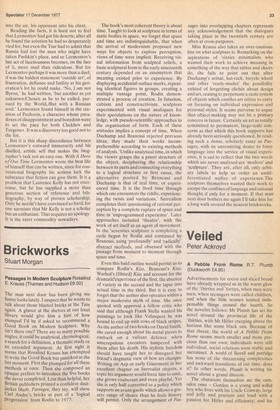Brickworks
Stuart Morgan
Passages In Modern Sculpture Rosalind E. Krauss (Thames and Hudson £9.50) The man next door has been giving me funny looks lately. I suspect that he wants to talk about those blasted bricks at the Tate again. A glance at the shelves at our local library would give him a hint of how stumped I'd be if asked to recommend a Good Book on Modern Sculpture. Why isn't there one? There are so many possible angles; it could be analytical, chronological, a search for a definition, a thematic study or an extended argument. At first sight it seems that Rosalind Krauss has attempted to write the Good Book but panicked at the last moment. First she plumped for all these methods at once. Then she composed an Opaque preface to introduce the five books she never completed. Less than helpful, her British publishers printed a confident dustJacket blurb. Passages, they say, will show Carl Andre's bricks as part of a 'logical progression' from Rodin to 1977. The book's most coherent theory is about time. Taught to look at sculpture in terms of static bodies in space, we forget that space and time are indistinguishable, that when the arrival of modernism proposed new ways for objects to explore perception, views of time were implicit. Receiving visual information from sculpted reliefs, a basic sculptural form in the early nineteenth century depended on an assumption that meaning existed prior to experience. By displaying accidental surface marks, repeating identical figures in groups, creating a multiple vantage point, Rodin demonstrated a process of creation. In futurism, cubism and constructivism, sculptors experimented with visual analogues for their speculations on the nature of knowledge, with pseudo-scientific approaches to the organisation of form. Each of these attitudes implies a concept of time. When Duchamp and Brancusi rejected previous ideas, they made their works incomprehensible according to existing methods of analysis. 'Unlike analytical time, in which the viewer grasps the a priori structure of the object, deciphering the relationship between its parts and connecting everything to a logical structure or first cause, the alternative posited by Brancusi and Duchamp is that of real time, or experienced time. It is the lived time through which one encounters the riddle, experiencing the twists and variations.' Surrealism completes their questioning of rational perception by a complete rupture of space and time in 'unprogrammed experience'. Later approaches included 'theatre', with the work of art itself as an agent of movement. In the 'seventies sculpture is completing a cycle begun by Rodin and continued by Brancusi, using 'profoundly' and 'radically' abstract methods, and obsessed with the passage from moment to moment through space and time. '
Even this bald outline would permit us to compare Rodin's Kiss, Brancusi's Kiss, Warhol's (filmed) Kiss and account for the dramatieexperience of the first, the absence of variety in the second and the lapse into actual time in the third. But it is easy to forget that the author also operates within a major modernist myth of time. She once quoted with approval a fellow critic who said that although Frank Stella wanted his paintings to look like Velasquez he was bound to end up with rows of black stripes. As the author of two books on David Smith, she cared enough about his metal pieces to embark 011 a valiant defence when unscrupulous executors tampered with them after his death. His stylistic freedom should have taught her to disregard her friend's dogmatic view of how art changes. Writing on Arp or early Giacometti in her excellent chapter on Surrealist objects,. a topic his argument would force him to omit, she grows exuberant and even playful. Yet she is only half converted to a policy which supports an avant-garde which allows a greater range of choice than he feels history will permit. Only the arrangement of Pas, sages into overlapping chapters represents any acknowledgement that the dialogues taking place in the twentieth century are often at cross-purposes.
Miss Krauss also takes an over-cautious line on what sculpture is. Remarking on the aspirations of 'sixties minimalists who wanted their work to achieve meaning in something of the way that tables and chairs do, she fails to point out that after Duchamp's urinal, hat-rack, bicycle wheel and other 'ready-mades' the possibility existed of forgetting cliches about design and art, ceasing to perpetuate a caste system of objects which enables art critics to carry on focusing on individual expression and personal styles. It seems perverse to argue that object-making may not be a primary concern in future. Certainly an art as totally committed to permanent, large-scale concerns as that which this book supports has already been seriously questioned. In reading such a dense, scholarly essay as Passages, with its unremitting desire to force language into the service of visual experience, it is sad to reflect that the two words which are never analysed arc 'modern' and 'sculpture'. They are, after all, only arbitary labels to help us order an undifferentiated welter of experience.The sculptors themselves wanted their work to escape the confines of language and rational thought, if only for a moment. If that man next door bothers me again I'll take him for a long walk around the nearest brickworks.


































 Previous page
Previous page